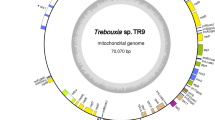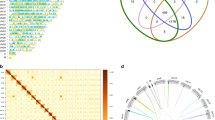Abstract
Photosynthetic dinoflagellates are important aquatic primary producers and notorious causes of toxic ‘red tides’. Typical dinoflagellate chloroplasts differ from all other plastids in having a combination of three envelope membranes1 and peridinin-chlorophyll a /c light-harvesting pigments2. Despite evidence of a dinoflagellete satellite DNA containing chloroplast genes3, previous attempts to obtain chloroplast gene sequences have been uniformly unsuccessful. Here we show that the dinoflagellate chloroplast DNA genome structure is unique. Complete sequences of chloroplast ribosomal RNA genes and seven chloroplast protein genes from the dinoflagellate Heterocapsa triquetra reveal that each is located alone on a separate minicircular chromosome: ‘one gene–one circle’. The genes are the most divergent known from chloroplast genomes. Each circle has an unusual tripartite non-coding region (putative replicon origin), which is highly conserved among the nine circles through extensive gene conversion, but is very divergent between species. Several other dinoflagellate species have minicircular chloroplast genes, indicating that this type of genomic organization may have evolved in ancestral peridinean dinoflagellates. Phylogenetic analysis indicates that dinoflagellate chloroplasts are related to chromistan and red algal chloroplasts and supports their origin by secondary symbiogenesis4,5,6.
This is a preview of subscription content, access via your institution
Access options
Subscribe to this journal
Receive 51 print issues and online access
$199.00 per year
only $3.90 per issue
Buy this article
- Purchase on Springer Link
- Instant access to full article PDF
Prices may be subject to local taxes which are calculated during checkout






Similar content being viewed by others
References
Dodge, J. D. Asurvey of chloroplast ultrastructure in Dinophyceae. Phycologia 14, 253–263 (1975).
Jeffrey, S. W. et al. Chloroplast pigment patterns in dinoflagellates. J. Phycol. 111, 374–384 (1975).
Boczar, B. A., Liston, J. & Cattolico, R. A. Characterization of satellite DNA from three marine dinoflagellates: Glenodinium sp. and two members of the toxic genus, Protogonyaulax. Plant Physiol. 97, 613–618 (1991).
Gibbs, S. P. The chloroplasts of some groups of algae may have evolved from endosymbiotic eukaryotic algae. Ann. NY Acad. Sci. 361, 193–207 (1981).
Cavalier-Smith, T. in Biodiversity and Evolution (eds Arai, R., Kato, M. & Doi, Y.) 75–114 (The National Science Museum Foundation, Tokyo, (1995).
Palmer, J. D. & Delwiche, C. F. in Molecular Systematics of Plants II (eds Soltis, D. E., Soltis, P. S. & Doyle, J. J.) 375–409 (Kluwer, Norwall, MA, (1998).
Martin, W. et al. Gene transfer to the nucleus and the evolution of chloroplasts. Nature 393, 162–165 (1998).
Douglas, S. E. & Penny, S. L. The plastid genome from the cryptomonad alga, Guillardia theta : complete sequence and conserved synteny groups confirm its common ancestry with red algae. J. Mol. Evol. 48, 236–244 (1999).
Morse, D., Salois, P., Markovic, P. & Hastings, J. W. Anuclear encoded form II RuBisCo in dinoflagellates. Science 268, 1622–1624 (1995).
Rowan, R., Whitney, S. W., Fowler, A. & Yellowless, D. Rubisco in marine symbiotic dinoflagellates: form II enzymes in eukaryotic oxygenic phototrophs, encoded by a nuclear multi-gene family. Plant Cell 8, 539–553 (1996).
Schlunegger, B. & Stutz, E. The Euglena gracilis chloroplast genome: structural features of a DNA region possibly carrying the single origin of DNA replication. Curr. Genet. 8, 629–634 (1984).
Wu, M., Lou, J. K., Chang, D. Y., Chang, C. H. & Nie, Z. Q. Structure and function of a chloroplast DNA replication origin of Chlamydomonas reinhardtii. Proc. Natl Acad. Sci. USA 83, 6761–6765 (1986).
Wakasugi, T. et al. Complete nucleotide sequence of the chloroplast genome from the green alga Chlorella vulgaris : the existence of genes possibly involved in chloroplast division. Proc. Natl Acad. Sci. USA 94, 5967–5972 (1997).
Boore, J. L. & Brown, W. M. Complete DNA sequence of the mitochondrial genome of the black chiton, Katharina tunicata. Genetics 138, 423–443 (1994).
Sugiura, M., Hirose, T. & Sugita, M. Evolution and mechanism of translation in chloroplasts. Annu. Rev. Genet. 32, 437–459 (1998).
Saunders, G. W., Hill, D. R. A., Sexton, J. P. & Andersen, R. A. Small-subunit ribosomal RNA sequences from selected dinoflagellates: testing classical evolutionary hypotheses with molecular systematic methods. Plant Syst. Evol. (suppl.) 11, 237–259 (1997).
Jacobs, J. D. et al. Characterisation of two circular plasmids from the marine diatom Cylindrotheca fusiformis : plasmids hybridise to chloroplast and nuclear DNA. Mol. Gen. Genet. 233, 302–310 (1992).
La Claire II, J. W., Loudenslager, C. M. & Zuccarello, G. C. Characterization of novel extrachromosomal DNA from giant celled marine green algae. Curr. Genet. 34, 204–211 (1998).
Backert, S., Nielsen, B. L. & Börner, T. The mystery of the rings: structure and replication of mitochondrial genomes from higher plants. Trends Plant Sci. 2, 477–483 (1987).
Wilson, R. J. M. et al. Complete map of the plastid-like DNA of the malaria parasite Plasmodium falciparum. J. Mol. Biol. 261, 155–172 (1996).
Gajadhar, A. A. et al. Ribosomal RNA sequences of Sarcocystis muris, Theileria annulata and Crypthecodinium cohnii reveal evolutionary relationships among apicomplexans, dinoflagellates and ciliates. Mol. Biochem. Parasitol. 45, 147–154 (1991).
Cavalier-Smith, T. Kingdom protozoa and its 18 phyla. Microbiol. Rev. 57, 953–994 (1993).
Waller, R. et al. Nuclear-encoded proteins target to the plastid in Toxoplasma gondii and Plasmodium falciparum. Proc. Natl Acad. Sci. USA 98, 12352–12357 (1998).
Sambrook, J., Fritsch, E. F. & Maniatis, T. Molecular Cloning, A Laboratory Manual2nd edn (Cold Spring Harbor Laboratory Press, Cold Spring Harbor, NY, (1989).
Smith, S. W. The genetic data environment and expandable GUI for multiple sequence analysis. Comp. Appl. Biosci. 10, 671–675 (1994).
Acknowledgements
We thank M. Beaton and K. Ishida for valuable discussion and advice; E. Filek for help with plasmid sequencing; X. Wu and E. Chao for advice on PCR; R. G. Hiller for communicating unpublished data; and J. Saldarriaga for H. rotundata and G. grindleyi total DNA. This work was supported by NSERC research grants to B.R.G. and T.C.-S. T.C.-S. thanks the Canadian Institute for Advanced Research for fellowship support.
Author information
Authors and Affiliations
Corresponding author
Rights and permissions
About this article
Cite this article
Zhang, Z., Green, B. & Cavalier-Smith, T. Single gene circles in dinoflagellate chloroplast genomes. Nature 400, 155–159 (1999). https://doi.org/10.1038/22099
Received:
Accepted:
Issue Date:
DOI: https://doi.org/10.1038/22099
This article is cited by
-
Characterization of Amphidinium (Amphidiniales, Dinophyceae) species from the China Sea based on morphological, molecular, and pigment data
Journal of Oceanology and Limnology (2022)
-
Comparison of 15 dinoflagellate genomes reveals extensive sequence and structural divergence in family Symbiodiniaceae and genus Symbiodinium
BMC Biology (2021)
-
Discovery of a kleptoplastic ‘dinotom’ dinoflagellate and the unique nuclear dynamics of converting kleptoplastids to permanent plastids
Scientific Reports (2019)
-
Symbiodinium genomes reveal adaptive evolution of functions related to coral-dinoflagellate symbiosis
Communications Biology (2018)
-
The Marine Dinoflagellate Alexandrium andersoni Induces Cell Death in Lung and Colorectal Tumor Cell Lines
Marine Biotechnology (2018)
Comments
By submitting a comment you agree to abide by our Terms and Community Guidelines. If you find something abusive or that does not comply with our terms or guidelines please flag it as inappropriate.



